Women in Nazi Germany
After the First World War women in Germany were given the vote and a feminist elite, led by Rosa Luxemburg and Clara Zetkin, helped to shape the political post-war scene. Luxemburg, the leader of the Spartacus League, was murdered by the Freikorps in January, 1919, but other women replaced her at the forefront of politics and by 1932 they had 36 members of the Reichstag. Germany also had 100,000 women teachers, 13,000 women musicians and 3,000 women doctors. (1)
The Wall Street Crash caused serious problems for the German economy. The collapse in share prices meant an urgent need to repatriate American capital invested abroad. The number of registered unemployed in Germany rose from 1.6 million in October 1929 to 6.12 million in February 1932. Since these figures did not include the "invisible" unregistered unemployed, it has been estimated that the true figure was 7.6 million. "Thirty-three per cent of the workforce were without jobs. Taking into account dependants, perhaps twenty-three million people were affected by unemployment." (2)
During the early 1930s women often found it easier to find jobs than men. The main reason was that female labour was cheaper. As Richard Grunberger has pointed out: "Skilled women earned 66 per cent of men's wages, unskilled ones 70 per cent, which explains why during the Depression nearly one man in three (29 per cent) was dismissed but only one woman in every ten (11 per cent)... In 1933 women formed 37 per cent of the total employed labour force in Germany. (3)
Unemployment and the Nazi Party
During the election campaign in 1932, Adolf Hitler promised that if he gained power he would take 800,000 women out of employment within four years. Hitler told a delegation who had come to discuss women's rights with him he told them the solution was for every woman to have a husband. The American journalist, William L. Shirer, who was working in Germany at the time, has argued that politicians such as Hitler "thrive only... when the masses were unemployed, hungry and desperate". (4) In the election in November 1932 the Nazi Party won 230 seats, making it the largest party in the Reichstag. The German National Party, won nearly a million additional votes. (5)
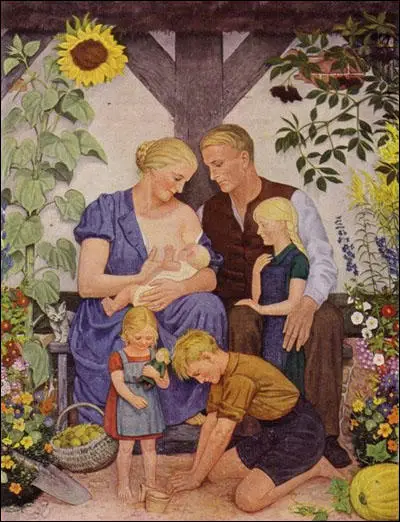
Cate Haste, the author of Nazi Women (2001) has suggested that Hitler was popular with German women. "When Hitler came to power, almost half of those voting for him were women. His promise to restore order and end unemployment held strong appeal. German women had experienced the anarchy of street fighting between rival political gangs on their doorsteps. Unemployment bred uncertainty and discord at the heart of their family lives. Women who worked to keep their families as their husbands lost their jobs, or who saw their standard of life deteriorate, longed for stability and certainty - feelings successfully tapped by Hitler." (6)
Melita Maschmann was a young German woman who supported Hitler because she believed he would bring an end to unemployment: "Part of the misery about which the adults complained daily was unemployment. One could have no conception of what it mean for four, five or even six million people to have no work. Berlin had four million inhabitants…Imagine all the families living in Berlin having scarcely enough dry bread to satisfy their hunger... I believed the National Socialists when they promised to do away with unemployment… I believed them when they said they would reunite the German nation, which had split into more than forty political parties, and overcome the consequences of the dictated peace of Versailles." (7)
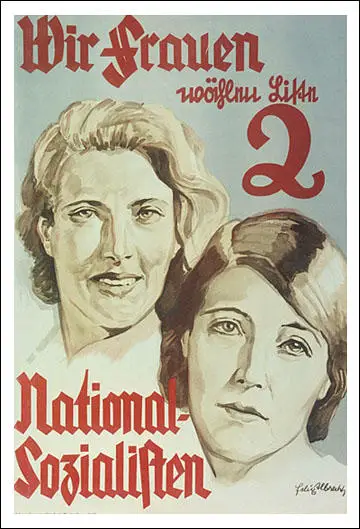
After taking power Hitler's main idea of reducing unemployment amongst men was by taking women out of the labour market. Ministers in the Nazi government made speech after speech encouraging women to allow men to take their jobs. Joseph Goebbels made a very important speech on the subject in March 1933. He pointed out that the Nazi Party had been criticized for keeping "women out of daily politics" in Germany. "We do not see the woman as inferior, but as having a different mission, a different value, than that of the man. Therefore we believed the German woman, who more than any other in the world is a woman in the best sense of the word, should use her strength and abilities in other areas than the man."
Goebbels condemned the idea that women had as much right as men to work. "Looking back over the past years of Germany’s decline, we come to the frightening, nearly terrifying, conclusion that the less German men were willing to act as men in public life, the more women succumbed to the temptation to fill the role of the man. The feminization of men always leads to the masculinisation of women. An age in which all great idea of virtue, of steadfastness, of hardness, and determination have been forgotten should not be surprised that the man gradually loses his leading role in life and politics and government to the woman."
Goebbels then went on to argue that in recent years: "Some good, noble, and commendable things have happened. But also things that are contemptible and humiliating. These revolutionary transformations have largely taken from women their proper tasks. Their eyes were set in directions that were not appropriate for them. The result was a distorted public view of German womanhood that had nothing to do with former ideals. A fundamental change is necessary. At the risk of sounding reactionary and outdated, let me say this clearly: The first, best, and most suitable place for the women is in the family, and her most glorious duty is to give children to her people and nation, children who can continue the line of generations and who guarantee the immortality of the nation. The woman is the teacher of the youth, and therefore the builder of the foundation of the future. If the family is the nation’s source of strength, the woman is its core and centre. The best place for the woman to serve her people is in her marriage, in the family, in motherhood." (8)
Women as Mothers
Adolf Hitler also reinforced this idea. In a speech he made in September 1934, he suggested that the slogan "emancipation of women" was invented by Jewish intellectuals and was clearly associated with Marxism. Women needed to leave the workplace and return to the home. " For her world is her husband, her family, her children, and her home. But what would become of the greater world if there were no one to tend and care for the smaller one? The great world cannot survive if the smaller world is not stable. We do not consider it correct for the women to interfere in the world of the man. We consider it natural if these two worlds remain distinct." (9)
Nazi propaganda was carefully designed to elevate women's role. Motherhood was glorified in posters, paintings and sculptures. "The breastfeeding mother appeared on sometimes graphically deplorable posters and was sculptured for placing in public spaces. Painters depicted mothers surrounded by their families in warm, soft-toned agricultural settings, intended to invoke the peasant rural idyll within which the Nazi fantasy of ideal family life was framed." (10)
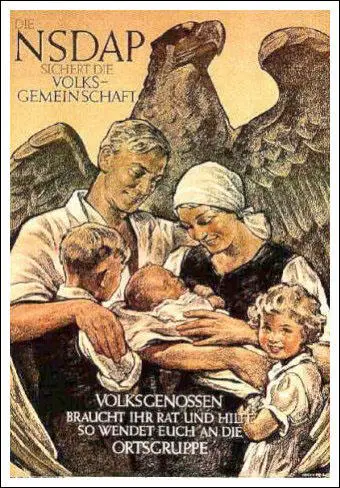
Adolf Hitler returned to the subject a few months later. He argued that the Nazi government was protecting the best interests of women by encouraging them to get married: "The so-called granting of equal rights to women, which Marxism demands, in reality does not grant equal rights but constitutes a deprivation of rights, since it draws the woman into an area in which she will necessarily be inferior. The woman has her own battlefield. With every child that she brings into the world, she fights her battle for the nation." (11)
Marianne Gärtner attended a meeting of the German Girls' League in Potsdam where she was told about the desirability of large, healthy families, the team leader raised her voice: "There is no greater honour for a German woman than to bear children for the Führer and for the Fatherland! The Führer has ruled that no family will be complete without at least four children, and that every year, on his mother's birthday, all mothers with more than four children will be awarded the Mutterkreuz." (Decoration similar in design to the Iron Cross (came in bronze, silver or gold, depending on number of children).
The team leader then asked for questions: "Why isn't the Führer married and a father himself?" Gärtner explained in her autobiography, The Naked Years: Growing up in Nazi Germany (1987): "The question was out before I had time to check myself. It was an innocent question, devoid of any pert insinuation that the Führer ought to practise what he preached. Silence filled the whitewashed room, but the team leader offered neither answer nor reproved the question. She strafed me with a murderous look, then called for attention." The question was never answered. (12)
Reduction of Unemployment
Soon after Hitler gained power he ordered the Reichstag to pass legislation that would reduce male unemployment. Young couples intending to get married could apply in advance for the interest-free loan of up to 1,000 Reichsmarks provided that the prospective wife had been in employment for at least six months in the two years up to the passing of the law. Importantly, she had to give up her job by the time of the wedding and undertake not to enter the labour market again until the loan was paid off, unless her husband lost his job in the meantime. To stimulate production the loans were issued not in cash but in the form of vouchers for furniture and household equipment. By the end of 1934, around 360,000 women had given up work in order to get married. (13)
As Richard Evans, the author of The Third Reich in Power (2005), has pointed out: "That this was not a short-term measure was indicated the terms of repayment, which amounted to 1 per cent of the capital per month, so that the maximum period of the loan could be as much as eight and a half years... However, the loans were made more attractive, and given an additional slant, by a supplementary decree issued on 20 June 1933 reducing the amount to be repaid by a quarter for each child born to the couple in question. With four children, therefore, couples would not have to repay anything." (14)
To pay for these loans single men and childless couples were taxed more heavily. The German government also made changes to the law to make marriage an instrument of racial policy. In 1934 the Nazi Racial Policy Bureau introduced ten rules to be observed when considering a marriage partner. This included "Remember you are a German.... Being a German, only choose a spouse or similar or related blood! When choosing your spouse, inquire into his or her forebears... Hope for as many children as possible! Your duty is to produce at least four offspring in order to ensure the future of the national stock." (15)
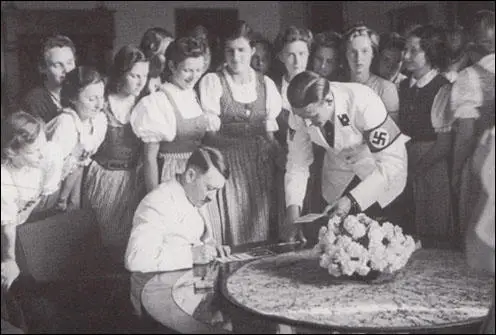
The German government also introduced measures to prevent these loans being obtained by people they did not believe deserved them. All applicants had to undergo a medical examination to see that they were really Aryans. If they had any hereditary diseases or were associated with oppositional movements like the German Communist Party and Social Democrat Party they were turned down for loans. By the end of 1934, around 360,000 women had given up work. (16)
Gertrud Scholtz-Klink
Adolf Hitler appointed Gertrud Scholtz-Klink as Reich Women's Leader and head of the German Girls' League. A good orator, Scholtz-Klink's main task was to promote male superiority and the importance of child-bearing. In one speech she pointed out that: "Woman is entrusted in the life of the nation with a great task, the care of man, soul, body, and mind. It is the mission of woman to minister in the home and in her profession to the needs of life from the first to last moment of man's existence. Her mission in marriage is... comrade, helper and womanly complement of man - this is the right of woman in the New Germany." (17)
In July 1934 Scholtz-Klink was appointed as head of the Women's Bureau in the German Labour Front. She now had responsibility for persuading women to work for the good of the Nazi government. The decline in unemployment after the Nazis gained power meant that it was not necessary to force women out of manual work. However, action was taken to reduce the number of women working in the professions. Married women doctors and civil servants were dismissed in 1934 and from June 1936 women could no longer act as judges or public prosecutors. Hitler's hostility to women was shown by his decision to make them ineligible to jury service because he believed them to be unable to "think logically or reason objectively, since they are ruled only by emotion." (18)
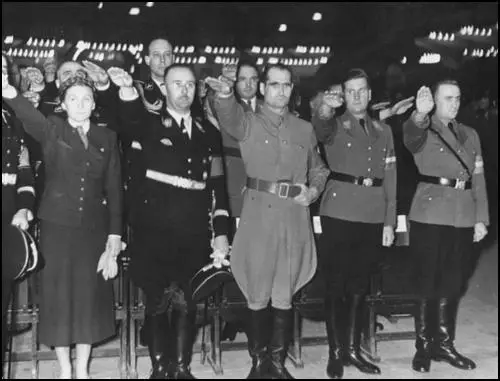
In 1936 Scholtz-Klink published To Be German Is to Be Strong where she argued that it was the role of women to be mothers in Nazi Germany. "Many women were superficially mothers (in the past), but they had forgotten to subordinate themselves to the law of life, which sees the affirmation of a child as the answer of the woman to her people, and also her contribution to the right of her people to survive. Transforming the calling of motherhood to the job of motherhood left children joyless, unhappy, without strength or soul. Devilish forces under the leadership of Marxism attempted to lead German women along this path. It is therefore our task to awaken once again the sense of the divine, to make the calling to motherhood the way through which the German woman will see her calling to be mother of the nation. She will then not live her life selfishly, but rather in service to her people." (19)
Traudl Junge argued that many young women were turned off Nazism by the image projected by Scholtz-Klink. "The Führerin Gertrud Scholtz-Klink was the type we did not like at all. She was just bourgeois and she was so ugly and wasn't fashionable at all. So that was why we didn't bother about joining her organization... It didn't touch me or my friends very much... We were interested in dancing and ballet, and I didn't care much for politics." Junge did not like the message that young women should not wear make-up and had to be "naturally beautiful, sporty and healthy, and giving her leader (Hitler) a lot of children." (20)
Education
One of the objectives of the Nazi government was to reduce the number of women in higher education. On 12th January 1934, Wilhelm Frick ordered that the proportion of female grammar school graduates allowed to proceed to university should be no more than 10 per cent of that of the male graduates. (21) That year, out of 10,000 girls who passed the Abitur entry examinations, only 1,500 were granted university admission. In the year before the Nazis came to power there were 18,315 women students in Germany's universities. Six years later this number had fallen to 5,447. The government also ordered a reduction in women teachers. By 1935 the number of women teachers at girls' secondary schools had decreased by 15 per cent. (22)
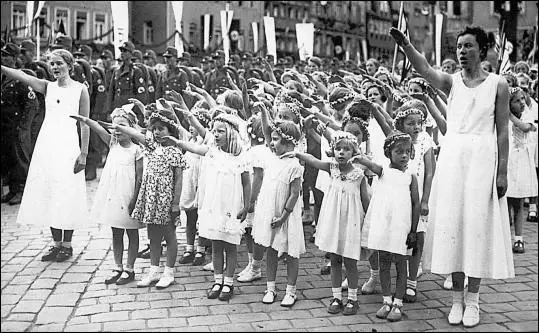
salute and singing the Horst-Wessel, the unofficial anthem of the Nazi Party.
Gertrud Scholtz-Klink was placed in charge of the Nazi Mother Service. The organization issued a statement explaining its role in Nazi Germany: "The purpose of the National Mother Service is political schooling. Political schooling for the woman is not a transmission of political knowledge, nor the learning of Party programs. Rather, political schooling is shaping to a certain attitude, an attitude that out of inner necessity affirms the measures of the State, takes them into women's life, carries them out and causes them to grow and be further transmitted."
Joseph Goebbels pointed out in a speech in 1934: "Women has the task of being beautiful and bringing children into the world, and this is by no means as coarse and old-fashioned as one might think. The female bird preens herself for her mate and hatches her eggs for him. In exchange, the mate takes care of gathering the food and stands guard and wards off the enemy. Hope for as many children as possible! Your duty is to produce at least four offspring in order to ensure the future of the national stock." (23)
As Richard Evans, the author of The Third Reich in Power (2005) has pointed out: "The reorganization of German secondary schools ordered in 1937 abolished grammar-school education for girls altogether. Girls were banned from learning Latin, a requirement for university entrance, and the Education Ministry did its best instead to steer them into domestic education, for which a whole type of girls school existed... The number of female students in higher education fell from just over 17,000 in 1932-33 to well under 6,000 in 1939." (24)
The Schutzstaffel (SS) also established bridal schools. Gertrud Draber later recalled: "I wanted to be a perfect housewife. And I wanted to do something different with my life, not just be a working girl in an office... None of us had a clue about running a household. So we were taught everything that was necessary to be a woman; house-keeping, being a mother, and being a good wife... My main aim as a woman was above all, and as soon as possible... to become a mother. That was my main ambition." (25)
Efforts to "propagate the master race" ended in failure. SS members managed by 1939 to produce on average only 1.1 children and the SS leaders a mere 1.4 children. This was far short of the four required by the State. Despite constant pressure, 43 per cent of SS members remained unmarried. (26)
Lebensborn
Heinrich Himmler urged members of the Schutzstaffel (SS) to get married and introduced a system where the more children they had, the less money they paid in tax. For example, "the deduction for a thirty-four-year-old married captain with no children was 3 per cent, with one child 2 per cent, two children 1.25 per cent and three children 0.4 per cent." (27)
Himmler also introduced regulations about the type of women SS members were allowed to marry. As one woman pointed out what happened when Ernst Trutz, an SS officer, proposed marriage: "He said I was a model of purebred Nordic Germanic woman.... and it was a sacred duty to give the Führer as many fine children as possible.... As the children of the SS men were going to be the new ruling class of Germany they had to be very careful that the women were not racially objectionable and had the right sort of physique to produce plenty of children. The marriage permit was only granted after an investigation by the Reich Ancestry Office and a medical examination by SS doctors." (28)
It became clear that even with these reforms not enough to encourage SS officers to have large families. The SS couple were expected to produce at least four children, but in fact the SS birthrate remained average for the country as a whole. (29) In December 1935 Himmler founded Lebensborn to care for unmarried mothers of "good blood" made pregnant by SS men. It was an attempt to stop these men arranging abortions and the consequent loss to the nation of "valuable" racial stock. These babies were then placed with SS families who wanted to adopt children. (30)
The first Lebensborn home was opened in 1936 in Steinhöring. Later that year Heinrich Himmler informed SS officers that the purpose of the programme was to: "(i) Support racially, biologically and hereditarily valuable families with many children. (ii) Place and care for racially, biologically and hereditarily valuable pregnant women, who, after thorough examination of their and the progenitor's families by the Race and Settlement Central Bureau of the SS, can be expected to produce equally valuable children." (31) Himmler used these maternity homes to promote the virtues of porridge and wholemeal bread. (32)
During this period an attempt was made to change views on illegitimate children. Adolf Hitler was quoted as saying that as long as there was an imbalance in the population of childbearing age, people "shall be forbidden to despise the child born out of wedlock". (33) According to Lisa Pine, the author of Nazi Family Policy (1997), the Nazi state no longer saw the single mother as "degenerate" and placed the single mother who had given a child life, higher than the woman who had "avoided having children in her marriage on egotistical grounds". (34)
It has been argued by the historian, Cate Haste, that in the 1930s "most European countries stigmatized unmarried mothers as a threat to the institution of marriage". In Nazi Germany, however, motherhood and procreation by women of "good blood" were so highly valued that steps were taken to "re-cast the image of the unmarried mother and illegitimate child". It was claimed the "bourgeois concept of marriage and morality was outmoded as far as Nazi population policy was concerned. (35) The Nazi campaign was "designed to confer parity of status as well as of public esteem on unmarried mothers and their offspring". (36)
Heinrich Himmler explained to his masseur, Felix Kersten: "Only a few years ago illegitimate children were considered a shameful matter. In defiance of the existing laws I have systematically influenced the SS to consider children, irrespective of illegality or otherwise, the most beautiful, and best thing there is. The results - today my men tell me with shining eyes that an illegitimate son has been born to them. Their girls consider it an honour, not a source of shame, in spite of existing legal circumstances." (37)
Leaders of the German Girls' League (BDM) were instructed to recruit young women with the potential to become good breeding partners for SS officers. Hildegard Koch was an 18 year-old member of the BDM in Berlin. She later recalled that she always appeared in the front line during BDM parades. "The Gau Leader herself had picked me from amongst hundreds of girls. I was half a head taller than the tallest of them and had wonderful long blonde hair and bright blue eyes.... Once I was photographed and my picture appeared on the tide page of the BDM journal Das deutsche Mädel." (38)
Hildegard was told by her BDM leader: "What Germany needs more than anything is racially valuable stock". She said that "Heinrich Himmler had been charged by the Führer with the task of coupling a small elite of German women (who had to be purely Nordic and over five foot tall) with SS men of equally good racial stock in order to lay the foundation of a pure racial breed.... We had to sign an undertaking renouncing all claims to the the children we would have there, as they would be needed by the State and would be taken to special houses and settlements for inter-marriage."
Hildegard was sent to an old castle near Tegernsee. "There were about 40 girls all about my own age. No one knew anyone else's name, no one knew where we came from. All you needed to be accepted there was a certificate of Aryan ancestry as far back at least as your great grandparents. This was not difficult for me. I had one that went back to the sixteenth century, nor had there ever been a smell of a Jew in our family." (39)
Jean Schlösser, a young woman from Cologne, was also sent to Tegernsee: "At the Tegernsee hostel, I waited until the tenth day after the beginning of my period and was medically examined; then I slept with an SS man who had also to perform his duty with another girl. When pregnancy was diagnosed, I had the choice of returning home or going straight into a maternity home... The birth was not easy, but no good German woman would think of having artificial injections to deaded the pain." (40)
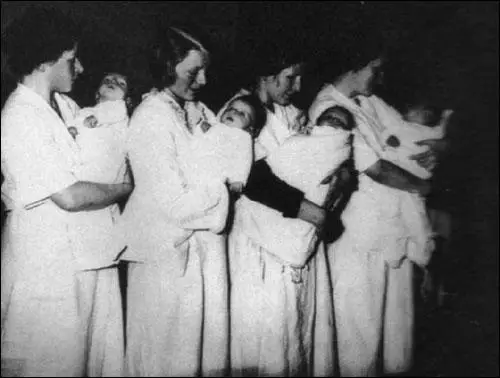
Hildegard Koch was introduced to several SS men at the Lebensborn maternity home. "They were all very tall and strong with blue eyes and blond hair... We were given about a week to pick the man we liked and we were told to see to it that his hair and eyes corresponded exactly to ours. We were not told the names of any of the men. When we had made our choice we had to wait till the tenth day after the beginning of the last period, when we were again medically examined and given permission to receive the SS men in our rooms at night... He was a sweet boy, although he hurt me a little, and I think he was actually a little stupid, but he had smashing looks. He slept with me for three evenings in one week. The other nights he had to do his duty with another girl. I stayed in the house until I was pregnant, which didn't take long." A boy was born but she was only able to stay with him for two weeks before handing him over to the SS. Hildegard agreed to come back in a year's time in order to provide another child for the regime. (41)
There were 14 Lebensborn clinics established in Germany and Austria. (42) Attempts were made to keep details of the SS breeding programme secret. Doctors swore an SS oath of silence. It was forbidden to photograph babies at the Lebensborn maternity homes and births were not registered through the official civil registry offices, but covered by a special certificate confirming their racial purity. (43)
Ellen Voie was one of the children born in a Lebensborn maternity home: 'I stayed there until I was adopted aged two. My adoptive parents were incredibly cruel: they beat me and locked me in a small, dark room for hours. To this day I'm still afraid of the dark and have nightmares.... I was very disruptive; I couldn't concentrate. When I was 16 the local priest refused to confirm me because I did not have a baptism certificate. I had to go to the local authority where I found out that my parents had changed my name. (44)
Louis P. Lochner, an American journalist, claims that in the autumn of 1937, he was travelling on a local Bavarian train when a girl passenger suddenly announced: "I am going to the SS Ordensburg Sonthofen to have myself impregnated." (45) Incidents like this started rumours that the SS was running "stud farms". As a result mothers warned their daughters to keep clear of SS men for fear that they would be "spirited off to one of the homes and used for breeding". (46)
Clothes and Makeup
Adolf Hitler had strong views on women. He described his own ideal woman as "a cute, cuddly, naive little thing - tender, sweet, and stupid." (47) This is why he was attracted to Eva Braun. According to Alan Bullock, the author of Hitler: A Study in Tyranny (1962): "Hitler became genuinely fond of Eva. Her empty-headedness did not disturb him; on the contrary, he detested women with views on their own." (48)
Hitler also disliked women who smoked and wore make-up. He made it clear about how young women in Nazi Germany should behave. The American journalist, Wallace R. Deuel, pointed out that he read in the Völkischer Beobachter, a newspaper controlled by the Nazi Party, that: "The most unnatural thing we can encounter in the streets is a German woman, who, disregarding all laws of beauty, has painted her face with Oriental warpaint." (49) Marianne Gärtner, a 12-year-old member of the German Girls' League (BDM), was told at one meeting: "A German woman does not use make-up! Only Negroes and savages paint themselves! A German woman does not smoke! She has a duty to her people to keep fit and healthy! (50)
The BDM played an important role in developing these values: "They were trained in Spartan severity, taught to do without cosmetics, to dress in the simplest manner, to display no individual vanity, to sleep on hard beds, and to forgo all culinary delicacies; the ideal image of those broad-hipped figures, unencumbered by corsets, was one of radiant blondeness, crowned by hair arranged in a bun or braided into a coronet of plaits. As a negative counter-image Nazi propaganda projected the combative, man-hating suffragettes of other countries." (51)
There was also a campaign against young women who smoked. Medical experts wrote articles claiming there was a positive correlation between excessive nicotine indulgence and infertility. One report argued that smoking harmed the ovaries and that a marriage between heavy smokers only produced 0.66 children on average compared to the normal average of three. (52)
If caught smoking, members of the BDM were in danger of being expelled. Hedwig Ertl, a loyal member of the BDM, fully supported these values: "The German woman must be faithful. She must not wear make-up and she should not smoke. She must be industrious and honest and she must want to have lots of children and be motherly." (53)
There was also a campaign in German newspapers against the idea of wearing trousers. Women were described as those "trouser-wenches with Indian warpaint". Magda Goebbels liked wearing trousers and she gained the support of her husband, Joseph Goebbels, to defend like-minded women: "Whether women wear slacks is no concern of the public. During the colder season women can safely wear trousers, even if the Party mutinies against this in one place or another. The bigotry bug should be wiped out." (54)
Adolf Hitler and Eva Braun
During his period in power Eva Braun was Hitler's mistress. However, this information was kept from the German people. The journalist, William L. Shirer, the author of The Rise and Fall of Nazi Germany (1959), has pointed out: "Very few Germans knew of her existence and even fewer of her relationship to Adolf Hitler." (55) Hitler's biographer, Alan Bullock claims that he never allowed her to appear in public with him. (56)
Hitler's secretary, Christa Schroeder, claims that the only woman Hitler ever loved was Geli Raubal. "After the death of his niece Geli, Christmas was really a torture for him, and not pleasant for us either. It's true that he allowed a Christmas tree to be put in the corner of the hall, but Christmas carols were not sung." Geli's room was kept like it was at the time of her death and Anni Winter, the housekeeper, was the only one allowed into the room. Schroeder commented that Eva Braun, "like all other females in Hitler's circle was ignorant of politics." (57)
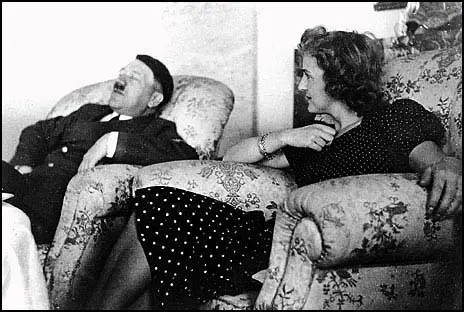
Traudl Junge argues that "Hitler didn't marry, he said himself, because he didn't want to lose his fascination for women. Obviously, an unmarried man is far more desirable than a boring husband... As a man, he didn't look attractive at all. It was more that he personified power - that was his fascination. And also his presence. He had a way of looking at you with those eyes, which could really set you alight. And somehow he was a mythical figure for women. He was a saviour, and he gave off an aura of power, and that impressed women. Like a Messiah, perhaps." (58)
The American journalist, Louis P. Lochner, believes that Hitler was very good at communicating with women. "I have heard the Führer address a group of German women, speaking so tenderly of his mother, expressing such fond concern for the problems of the housewife, tracing so eloquently what the German women had done and could do for the Nazi cause, that the listeners were in tears." (59)
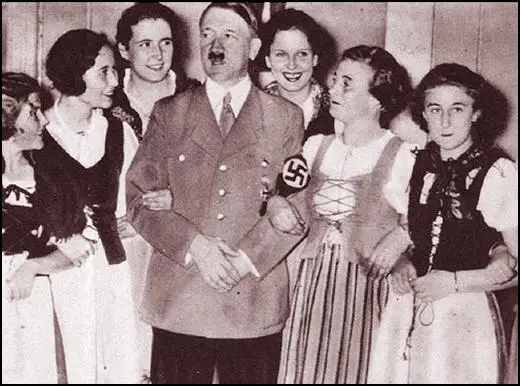
Katharine Thomas, a British visitor to Nazi Germany, saw him speak at a public meeting: "His words had power. He was emotional. He was sentimental, he was never intellectual... The lonely bachelor, the non-smoker, the crusading teetotaller - the glorious fighter for Germany's honour who had gone to prison for his convictions. It was a richly emotional picture for the women to gaze on." (60)
Cate Haste, the author of Nazi Women (2001) has pointed out: "Hitler's cultivation of women inspired their adulation. He was inundated with love letters from adoring fans. Women sent him presents - embroidered handkerchiefs, slippers stitched with the swastika and the rising sun, and cakes baked specially for him. Besotted women poured out their longing for him." Traudl Junge who open his letters and said many women offered themselves to him. One woman wrote that she wanted his child: "Just the thought that you, of all people, should have no children gives me no peace." (61)
Women in the Second World War
In 1937 Hitler's government changed its attitude towards women in the work-force. With the build-up for war, it now needed married women to seek employment in industry. It now rescinded its stipulation that women qualified for marriage loans only if they undertook not to enter the labour market. Within a few months women made up a third of the employed workforce. (62)
Gertrud Scholtz-Klink as Reich Women's Leader, issued a statement that said: "It has always been our chief article of fact that woman's place is in the home - but since the whole of Germany is our home we must serve her wherever we can best do so." However, she admitted in 1938 that she "had not once had the chance to discuss women's affairs in person with the Führer." (63)
In 1939 all young women up to the age of twenty-five had to compete a year of Labour Service before being allowed to take up paid employment. Nine out of ten young women were sent to farms where they lived in barrack-like accommodation under close supervision. It was seen as the female parallel to compulsory military service, aimed at producing a trained labour force in the event of war. It was also a source of cheap labour as the girls received only pocket money rather than wages. (64)
Melita Maschmann did her Labour Service in rural East Prussia. She later recalled that she found the whole experience uplifting: "Our camp community was a model in miniature of what I imagined the National Community... Never before or since have I known such a good community, even where the composition was more homogeneous in every respect. Amongst us there were peasant girls, students, factory girls, hairdressers, schoolgirls, office workers and so on... The knowledge that this model of a National Community had affected me such intense happiness gave birth to an optimism to which I clung obstinately until 1945." (65)
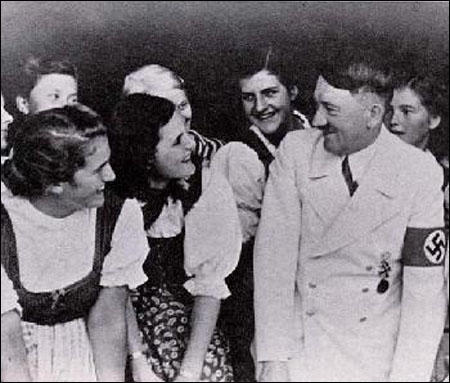
Martin Bormann suggested that the army should form women's battalions during the war. Gertrud Scholtz-Klink was always against the idea of women serving in the army. She argued: "I have sons in the war, I will protect my daughters." Despite her opposition in 1942 women were assigned to military duties as "Female Wehrmacht Auxiliaries". (66)
Scholtz-Klink received support from Dr. Jutta Rüdiger, the head of the Bund Deutscher Mädel (League of German Girls): "It is out of the question. Our girls can go right up to the front and help them there, and they can go everywhere, but to have a women's battalion with weapons in their hands fighting on their own, that I do not support. It's out of the question. If the Wehrmacht can't win this war, then battalions of women won't help either." Baldur von Schirach said "Well, that's your responsibility". Rüdiger retorted: "Women should give life and not take it. That's why we were born." (67)
On 27th January 1943, after the defeat at Stalingrad, there was an attempt at total mobilization of female labour. Fritz Saukel, the Reich's plenipotentiary for labour conscription, called up 3 million women aged seventeen to forty-five. Only mothers with one child under six, or two children under fourteen, and women in poor health were to be exempt. It is estimated that of the 3 million potential additional workers, only just over 900,000 were actually inducted into the economy. (68)
Karma Rauhut was sent to work at a Luftwaffe ministry building. She was highly critical of the Nazi government and considered joining the resistance but eventually decided to carry on working for the regime: "The organizations were everywhere and the human beings reported each other and one watched the other... It was like you were in a spiderweb and the spider always noticed it something vibrated somewhere and did not ring true... You could only do resistance if you took death into consideration. Or horrible torture and also torture for your whole family... We were not all heroes... Not everyone is born to heroism." (69)
Women and the Resistance
Some women continued to resist the Nazi government but if caught they were punished harshly. Minna Cammens, a Social Democrat Party activist, was arrested for distributing pamphlets. A few days later her husband received her ashes in a cigarette case. Most people gave up hope. As one woman pointed out: "Open conversations became exceedingly rare... The possibility of meeting without consequences diminished. Hopelessness cast a pall over us like death." (70)
The Nazis opened their first concentration camp for women at Moringen in Lower Saxony. By 1938 the camp was unable to accommodate the growing number of women prisoners and a second one was built at Lichtenburg, near Wittenberg. The following year another one was opened in Ravensbrück. Located 50 miles north of Berlin it was surrounded by swampland. The camp could accommodate about 6,000 prisoners at a time. According to Louis L. Snyder an estimated 50,000 women died in Ravensbrück. (71)
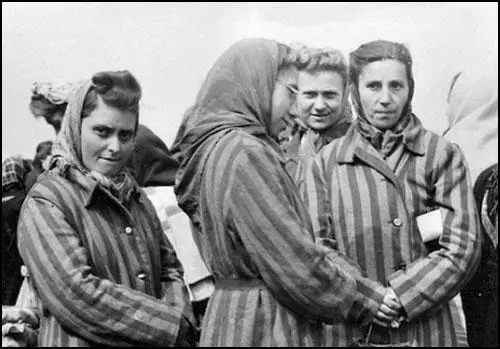
Sophie Scholl was a philosophy student at the University of Munich when she helped form the White Rose group. It was decided to adopt the strategy of passive resistance that was being used by students fighting against racial discrimination in the United States. In Passive Resistance to National Socialism, Scholl and her friends explained their objectives. "We want to try and show that everyone is in a position to contribute to the overthrow of the system. It can be done only by the cooperation of many convinced, energetic people - people who are agreed as to the means they must use. We have no great number of choices as to the means. The meaning and goal of passive resistance is to topple National Socialism, and in this struggle we must not recoil from our course, any action, whatever its nature. A victory of fascist Germany in this war would have immeasurable, frightful consequences." (72)
Sophie was arrested for distributing leaflets and she appeared before the People's Court judge, Roland Friesler, on 20th February, 1943. She told the court: "Somebody, after all, had to make a start. What we wrote and said is also believed by many others. They just don't dare express themselves as we did." Found guilty of sedition she was executed by guillotine a few hours later. Her cell-mate, Else Gebel, said Sophie's last words were: "It is such a splendid sunny day, and I have to go. But how many have to die on the battlefield in these days, how many young, promising lives. What does my death matter if by our acts thousands are warned and alerted." (73)
Primary Sources
(1) Adolf Hitler, speech to the NSDAP Women's Organization (September, 1934)
The slogan "emancipation of women" was invented by Jewish intellectuals. If the man's world is said to be the State, his struggle, his readiness to devote his powers to the service of the community, then it may perhaps be said that the woman's in a smaller world. For her world is her husband, her family, her children, and her home. But what would become of the greater world if there were no one to tend and care for the smaller one? The great world cannot survive if the smaller world is not stable. We do not consider it correct for the women to interfere in the world of the man. We consider it natural if these two worlds remain distinct.
(2) G. Zienef, Education for Death (1942)
I spent an hour with the principal, a very friendly, neat lady of fifty. She explained that every class in school was built around a course called Frauenschaffen, activities of women. This general subject was divided into: Handarbeit (handwork), Hauswirtschaft (domestic science,cooking, house and garden work), and most important, the Pflege course (eugenics, and hygiene, devoted to a study of the reproductive organs, both male and female, conception, birth, racial purity, infant care, family welfare).
She told me that the Fuehrer wanted the girls to feel that their bodies were more important for the State than their minds. He wanted girls to be proud of their bodies. He wanted them to get interested in the bodies of their sweethearts. If a girl had a healthy body, fit for childbirth, she should be proud to display it to advantage.
(3) Adolf Hitler, speech (September, 1935)
The so-called granting of equal rights to women, which Marxism demands, in reality does not grant equal rights but constitutes a deprivation of rights, since it draws the woman into an area in which she will necessarily be inferior. The woman has her own battlefield. With every child that she brings into the world, she fights her battle for the nation.
(4) Isle McKee was a member of the German Girls' League, later recalled her experiences in her autobiography.
We were told from a very early age to prepare for motherhood, as the mother in the eyes of our beloved leader and the National Socialist Government was the most important person in the nation. We were Germany's hope in the future, and it was our duty to breed and rear the new generation of sons and daughter. These lessons soon bore fruit in the shape of quite a few illegitimate small sons and daughters for the Reich, brought forth by teenage members of the League of German Maidens. The girls felt they had done their duty and seemed remarkably unconcerned about the scandal.
(5) Jutta Rüdiger, heard Adolf Hitler to speak in Düsseldorf in 1932.
It was a huge hall and everyone was waiting for Hitler to arrive... I must say it was an electrifying atmosphere. Even before 1933 everybody was waiting for him as if he was a saviour. Then he went to the podium. I remember it all went quiet, and he started to speak in his serious voice. Calm, slow, and then he got more and more enthusiastic. I must admit, I can't remember exactly what he actually said. But my impression afterwards was: this is a man who does not want anything for himself, but only thinks about how he can help the German people.
(6) Nazi Racial Policy Bureau, ten rules to be observed when considering a marriage partner (1934)
Remember you are a German.
Remain pure in mind and spirit!
Keep your body pure!
If hereditarily fit, do not remain single!
Marry only for love.
Being a German, only choose a spouse or similar or related blood!
When choosing your spouse, inquire into his or her forebears!
Health is essential to outward beauty as well!
Seek a companion in marriage, not a playmate.
Hope for as many children as possible! Your duty is to produce at least four offspring in order to ensure the future of the national stock.
(7) Liselotte Katscher was a member of the National Socialist German Workers Party who worked as a nurse. She later recalled how a sixteen year old girl was sterilized because she was deemed unfit for motherhood.
Henny was examined by a doctor who diagnosed a slight feeble-mindedness - in my opinion it was only a slight feeble-mindedness, and they decided that she should be sterilized. I thought about it a great deal at the time, and I felt sorry for the girl, but it was the law, and the doctors had decided. I personally took her to the maternity ward in the hospital where it took place. But I never got rid of the doubt in my mind that the decision was too harsh. I formed the impression when dealing with this young girl that she was perfectly capable of leading a normal life. The tragedy was that she was released very soon after this, then got a job and met a nice young man, and was now not allowed to marry him because of her sterilization.
(8) Martha Dodd, My Years in Germany (1939)
Young girls from the age of ten onward were taken into organizations where they were taught only two things: to take care of their bodies so they could bear as many children as the state needed and to be loyal to National Socialism. Though the Nazis have been forced to recognize, through the lack of men, that not all women can get married. Huge marriage loans are floated every year whereby the contracting parties can borrow substantial sums from the government to be repaid slowly or to be cancelled entirely upon the birth of enough children. Birth control information is frowned on and practically forbidden.
Despite the fact that Hitler and the other Nazis are always ranting about "Volk ohne Raum" (a people without space) they command their men and women to have more children. Women have been deprived for all rights except that of childbirth and hard labour. They are not permitted to participate in political life - in fact Hitler's plans eventually include the deprivation of the vote; they are refused opportunities of education and self-expression; careers and professions are closed to them.
(9) Joseph Goebbels, speech in Munich (March, 1933)
It is a happy accident that my first speech since taking charge of the Ministry of Public Enlightenment and Propaganda is to German women. Although I agree with Treitschke that men make history, I do not forget that women raise boys to manhood. You know that the National Socialist movement is the only party that keeps women out of daily politics. This arouses bitter criticism and hostility, all of it very unjustified. We have kept women out of the parliamentary-democratic intrigues of the past fourteen years in Germany not because we do not respect them, but because we respect them too much. We do not see the woman as inferior, but as having a different mission, a different value, than that of the man. Therefore we believed the German woman, who more than any other in the world is a woman in the best sense of the word, should use her strength and abilities in other areas than the man.
The woman has always been not only the man’s sexual companion, but also his fellow worker. Long ago, she did heavy labor with the man in the field. She moved with him into the cities, entering the offices and factories, doing her share of the work for which she was best suited. She did this with all her abilities, her loyalty, her selfless devotion, her readiness to sacrifice. The woman in public life today is no different than the women of the past. No one who understands the modern age would have the crazy idea of driving women from public life, from work, profession, and bread winning. But it must also be said that those things that belong to the man must remain his. That includes politics and the military. That is not to disparage women, only to recognise how she best uses her talents and abilities.
Looking back over the past years of Germany’s decline, we come to the frightening, nearly terrifying, conclusion that the less German men were willing to act as men in public life, the more women succumbed to the temptation to fill the role of the man. The feminisation of men always leads to the masculinisation of women. An age in which all great idea of virtue, of steadfastness, of hardness, and determination have been forgotten should not be surprised that the man gradually loses his leading role in life and politics and government to the woman.
It may be unpopular to say this to an audience of women, but it must be said, because it is true and because it will help make clear our attitude toward women.
The modern age, with all its vast revolutionary transformations in government, politics, economics, and social relations has not left women and their role in public life untouched. Things we thought impossible several years or decades ago are now everyday reality. Some good, noble, and commendable things have happened. But also things that are contemptible and humiliating. These revolutionary transformations have largely taken from women their proper tasks. Their eyes were set in directions that were not appropriate for them. The result was a distorted public view of German womanhood that had nothing to do with former ideals.
A fundamental change is necessary. At the risk of sounding reactionary and outdated, let me say this clearly: The first, best, and most suitable place for the women is in the family, and her most glorious duty is to give children to her people and nation, children who can continue the line of generations and who guarantee the immortality of the nation. The woman is the teacher of the youth, and therefore the builder of the foundation of the future. If the family is the nation’s source of strength, the woman is its core and centre. The best place for the woman to serve her people is in her marriage, in the family, in motherhood.
This is her highest mission. That does not mean that those women who are employed or who have no children have no role in the motherhood of the German people. They use their strength, their abilities, their sense of responsibility for the nation, in other ways. We are convinced, however, that the first task of a socially reformed nation must be to again give the woman the possibility to fulfil her real task, her mission in the family and as a mother.
The national revolutionary government is everything but reactionary. It does not want to stop the pace of our rapidly moving age. It has no intention of lagging behind the times. It wants to be the flag bearer and pathfinder of the future. We know the demands of the modern age. But that does not stop us from seeing that every age has its roots in motherhood, that there is nothing of greater importance than the living mother of a family who gives the state children.
German women have been transformed in recent years. They are beginning to see that they are not happier as a result of being given more rights but fewer duties. They now realise that the right to be elected to public office at the expense of the right to life, motherhood, and her daily bread is not a good trade. A characteristic of the modern era is a rapidly declining birthrate in our big cities. In 1900, two million babies were born in Germany. Now the number has fallen to one million.
This drastic decline is most evident in the nation’s capital. In the last 14 years, Berlin’s birthrate has become the lowest of any European city. By 1955, without emigration, it will have only about three million inhabitants. The government is determined to halt this decline of the family and the resulting impoverishment of our blood. There must be a fundamental change. The liberal attitude toward the family and the child is responsible for Germany’s rapid decline.
We today must begin worrying about an aging population. In 1900 there were seven children for each elderly person, today it is only four. If current trends continue, by 1988 the ratio will be 1:1. These statistics say it all. They are the best proof that if Germany continues along its current path, it will end in an abyss with breathtaking speed. We can almost determine the decade when Germany collapses because of depopulation.
We are not willing to stand aside and watch the collapse of our national life and the destruction of the blood we have inherited. The national revolutionary government has the duty to rebuilt the nation on its original foundations, to transform the life and work of the woman so that it once again best serves the national good. It intends to eliminate the social inequalities so that once again the life of our people and the future of our people and the immortality of our blood is assured.”
(10) Joseph Goebbels, speech in Munich (1934)
Women has the task of being beautiful and bringing children into the world, and this is by no means as coarse and old-fashioned as one might think. The female bird preens herself for her mate and hatches her eggs for him. In exchange, the mate takes care of gathering the food and stands guard and wards off the enemy.
(11) Adolf Hitler, speech on 26th January, 1942.
I detest women who dabble in politics. And if their dabbling extends to military matters it becomes utterly unendurable. In no section of the Party has a woman ever had the right to hold even the smallest post.
In 1924 we had a sudden upsurge of women who were interested in politics. They wanted to join the Reichstag, in order to raise the moral level of that body, so they said. I told them that 90 per cent of the matters dealt with by parliament were masculine affairs, on which they could not have opinions of any value. Gallantry forbids one to give women an opportunity of putting themselves in situations that do not suit them.
(12) Jutta Rüdiger, head of the German Girls' League, was shocked when she heard a speech given by in 1939 Heinrich Himmler in 1939.
He said that in the war a lot of men would be killed and therefore the nation needed more children, and it wouldn't be such a bad idea if a man, in addition to his wife, had a girlfriend would bear his children. And I must say, all my leaders were sitting there with their hair standing on end.
(13) Richard Grunberger, A Social History of the Third Reich (1971)
The truth was that female labour was cheaper: skilled women earned 66 per cent of men's wages, unskilled ones 70 per cent, which explains why during the Depression nearly one man in three (29 per cent) was dismissed but only one woman in every ten (11 per cent). Furthermore women workers were indispensable. In 1933 women formed 37 per cent of the total employed labour force in Germany. Every second agricultural worker was female; in addition, 75 per cent of female labour on the land was not hired but consisted of members of the family.
Since the absorption of men into the resurgent economy proceeded at a much faster rate than that of women - between 1933 and 1937 800,000 newly married women received loans on condition of not seeking re-employment - the female proportion of the total labour force declined to 31 per cent in 1937, although the total numbers actually increased. By 1939, women again constituted exactly a third of the employed labour force, comprising nearly 7 million white-collar and blue-collar workers. In industry as a whole they represented almost a quarter (23 per cent) of the personnel.
(14) Cate Haste, Nazi Women (2001)
On 30 January 1933, the Nazis came to power. They celebrated with a huge parade: column after column of uniformed men - swastika banners waving, torches burning and music playing- marched through the Brandenburg Gate and took over the streets of Berlin. In this massive show of political strength, there was not a single woman.
From the foundation of the Nazi Party in 1921, women were denied any position of power in its hierarchy - the only reference to women in its programme was Point 21, which pledged protection for mothers. Since winning the vote in 1918, women had been elected in significant numbers to represent all the other main parties in local and regional government, and in the German Reichstag, where they made up 10 per cent of deputies. In the National Socialist Party there were no women representatives at all...The Nazis offered women a special role - as companions to warrior husbands in forging the Thousand Year Reich. Their mission was to be wives supporting their husbands, and mothers breeding the future master race. In this, their "true" role, they would be valued in the New Germany...
When Hitler came to power, almost half of those voting for him were women. His promise to restore order and end unemployment held strong appeal. German women had experienced the anarchy of street fighting between rival political gangs on their doorsteps. Unemployment bred uncertainty and discord at the heart of their family lives. Women who worked to keep their families as their husbands lost their jobs, or who saw their standard of life deteriorate, longed for stability and certainty - feelings successfully tapped by Hitler.
(15) Gertrud Scholtz-Klink, To Be German Is to Be Strong (1936)
The National Socialist movement sees the man and the woman as equal bearers of Germany’s future. It asks, however, for more than in the past: that each should first completely accomplish the tasks that are appropriate to his or her nature.
The woman, besides caring for her own children, should first care for those who need her help as mothers of the nation. This primarily involves thinking about family law and supporting families, youth legislation, and protecting the youth. It also requires thinking about the occupational paths that female youth will follow in the coming years, since some men and women are still unemployed, and some changes in women’s work will therefore be needed. Given our relations with each other, we affirm these temporary measures because we have firm faith that we have the strength to overcome the many present difficulties that our people faces. Our love for our people, however, will never allow these temporary difficulties to cause conflicts only for the sake of conflict, or that they be interpreted by sensation-hungry individuals as a failure of the National Socialist worldview.
We are always being asked if we see everything that has to be done in the area of women’s work. We can only say that each has the right and the opportunity to work with us and to follow the path leading to the resurrection of our people. However, we must sense love and concern, we must see that he comes to us because of a love for his people. Empty intellectual thinking or a superiority complex have never saved a people.
Women, I wish to try briefly to make clear what the deepest calling we women have is: motherhood. In the bad fourteen years between 1918 and 1933, motherhood was often robbed of its deepest meaning and reduced to something superficial, something that was even held in contempt. Instead of a child being seen as the deepest affirmation of the woman and of life, it was seen as a burden, as a sacrifice on the part of the woman. A child was often seen not as a great link to God as the creator of all life, before whom we must bow with folded hands and trembling hearts, but rather very often as the result of a weak mind and as an escape from the great events of life.
Many women were superficially mothers, but they had forgotten to subordinate themselves to the law of life, which sees the affirmation of a child as the answer of the woman to her people, and also her contribution to the right of her people to survive.
Transforming the calling of motherhood to the job of motherhood left children joyless, unhappy, without strength or soul. Devilish forces under the leadership of Marxism attempted to lead German women along this path.
It is therefore our task to awaken once again the sense of the divine, to make the calling to motherhood the way through which the German woman will see her calling to be mother of the nation. She will then not live her life selfishly, but rather in service to her people.
Student Activities
Adolf Hitler's Early Life (Answer Commentary)
The Assassination of Reinhard Heydrich (Answer Commentary)
Heinrich Himmler and the SS (Answer Commentary)
The Last Days of Adolf Hitler (Answer Commentary)
Trade Unions in Nazi Germany (Answer Commentary)
Adolf Hitler v John Heartfield (Answer Commentary)
Hitler's Volkswagen (The People's Car) (Answer Commentary)
Women in Nazi Germany (Answer Commentary)
German League of Girls (Answer Commentary)
Kristallnacht (Answer Commentary)
The Political Development of Sophie Scholl (Answer Commentary)
The White Rose Anti-Nazi Group (Answer Commentary)
The Hitler Youth (Answer Commentary)
Night of the Long Knives (Answer Commentary)
British Newspapers and Adolf Hitler (Answer Commentary)
An Assessment of the Nazi-Soviet Pact (Answer Commentary)
Lord Rothermere, Daily Mail and Adolf Hitler (Answer Commentary)
Adolf Hitler and the Beer Hall Putsch (Answer Commentary)
Adolf Hitler and the First World War (Answer Commentary)
Adolf Hitler and the German Workers' Party (Answer Commentary)
Adolf Hitler the Orator (Answer Commentary)
Sturmabteilung (SA) (Answer Commentary)
Who Set Fire to the Reichstag? (Answer Commentary)
Appeasement (Answer Commentary)
